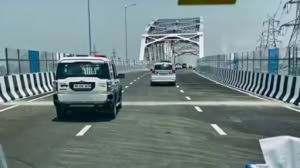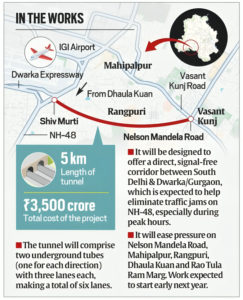Delhi–NCR Congestion Relief through a 5 km Tunnel: A Game‑Changer for Commuters
Introduction
In response to mounting traffic woes between South Delhi and the National Capital Region (NCR), authorities have green‑lit a bold infrastructure solution: a 5 km underground tunnel designed to streamline vehicular flow and slash commute times. यह टनल सिर्फ एक सड़क नहीं, बल्कि commuters के लिए उम्मीद और convenience का प्रतीक है। By diverting a significant chunk of through‑traffic below ground, the project aims to decongest arterial roads, reduce pollution, and improve overall travel experience.

Background and Project Overview
South Delhi–NCR corridor witnesses thousands of vehicles daily, leading to:
- Chronic traffic jams on arterial roads like the Mehrauli–Gurgaon stretch
- Increased air pollution from idling vehicles
- Longer commute times, often exceeding 90 minutes for a 20 km trip
To tackle these challenges, the Delhi Development Authority (DDA) and the National Highways Authority of India (NHAI) joined forces:
- Route Selection: The tunnel runs from near Chhatarpur Metro Station to the outskirts of Gurgaon.
- Design Specifications: Two‑lane carriageway in each direction, emergency evacuation passages, and advanced ventilation and fire‑safety systems.
- Construction Technology: Tunnel Boring Machine (TBM) with state‑of‑the‑art slurry shield technology to ensure minimal surface disruption.
यह high‑tech TBM मिट्टी को नियंत्रित तरीके से हटाता है, जिससे आसपास के structures पर असर न्यूनतम रहता है।
Key Benefits for Commuters
Faster Transit and Reduced Congestion
By bypassing surface roads, commuters can expect:
- Travel time reduction by up to 40% (from 90 to 50 minutes during peak hours).
- Seamless movement without multiple signal crossings.
- Predictable journey times, aiding planning for work and appointments.
Environmental Gains
Cutting down surface gridlock has significant eco‑benefits:
- Lower vehicular emissions: Less idling in traffic means reduced CO₂ and NOₓ levels.
- Noise pollution control: Underground travel dampens engine and horn noise.
- Improved air quality in residential areas adjacent to the tunnel route.
Safety and Reliability
The tunnel incorporates multiple safety features:
- Intelligent Lighting Systems: Adaptive LED lighting that adjusts based on visibility conditions.
- Emergency Lay‑Bys every 500 m for breakdowns.
- 24×7 Monitoring with CCTV cameras and automated incident detection.
- Fire‑Suppression Systems: Water mist and foam cannons ready to activate within seconds.
यात्रियों की सुरक्षा सर्वोच्च प्राथमिकता है, और यह tunnel इस दृष्टिकोण को प्रतिबिंबित करता है।
Technical Highlights
TBM and Engineering Excellence
The slurry‑shield TBM used here excels in:
- Ground Stabilization: Injecting bentonite slurry to support tunnel face.
- Spoil Removal: Efficient conveyor systems transport muck to the surface.
- Precision Alignment: Laser‑guided steering ensures alignment within ±10 mm.
Ventilation and Air Quality Control
Maintaining breathable air underground is crucial:
- Longitudinal Ventilation using jet fans to push fresh air through the tunnel length.
- Air Quality Sensors monitor particulate matter (PM₂.₅) and CO levels in real time.
- Automated Control adjusts fan speed and opens ventilation shafts as needed.
Drainage and Waterproofing
Given Delhi’s monsoon intensity, waterproofing is vital:
- Precast Segment Liners with gasket seals prevent water ingress.
- Sub‑floor Drainage Channels collect seepage and divert it to sump pumps.
- Redundant Pumping Systems ensure continuous operation during heavy rains.
Real‑Life Impact and Case Studies
Case Study: Gothenburg’s Tunnel Success
In Sweden, the Marieholm Tunnel in Gothenburg delivered:
- 30% traffic reduction on surface routes
- 20 µg/m³ drop in NO₂ levels after one year of operation
- High user satisfaction, with commuters praising reduced stress
इसी मॉडल को Delhi–NCR में लागू करके similar gains की उम्मीद की जा रही है।
Commuter Testimonials
- “मेरे घर से ऑफिस तक अब सिर्फ 45 मिनट लगते हैं—पहले मैं 2 घंटे ट्रैफिक में बिता देता था।”
- “Air quality मेरे commute के दौरान noticeably बेहतर लगती है।”
Implementing a User‑First Approach
To ensure the tunnel truly serves commuters, authorities are:
- Conducting Pre‑Opening Drills: Emergency response teams run mock evacuations and safety checks.
- Gathering Public Feedback: Online portals and helplines collect commuter suggestions.
- Offering Integrated Ticketing: Planning to integrate toll payments with FASTag for cashless transit.
- Providing Real‑Time Updates: A mobile app with live traffic and air‑quality data inside the tunnel.
यह user‑first दृष्टिकोण सुनिश्चित करता है कि technology सिर्फ infrastructure नहीं, बल्कि एक enhanced experience भी हो।
Conclusion
The 5 km tunnel under South Delhi–NCR corridor marks a significant step toward decongesting one of India’s busiest commuting routes. Faster travel times, improved air quality, and world‑class safety measures promise a transformative impact for daily travelers. जैसा कि metropolitan challenges बढ़ रहे हैं, ऐसे innovative solutions critical हैं। As the tunnel opens to traffic, commuters stand to gain in convenience and well‑being, redefining urban mobility in the capital region.
